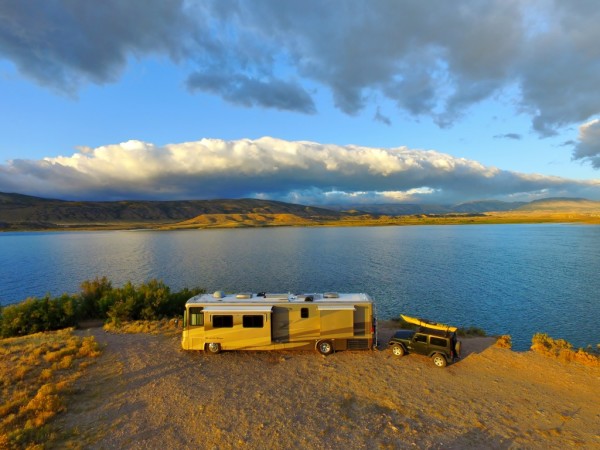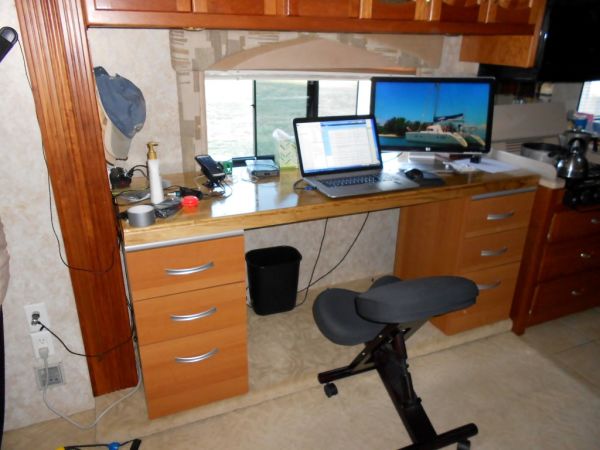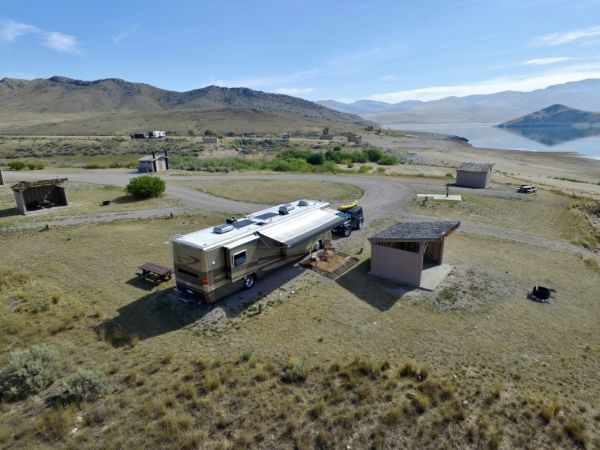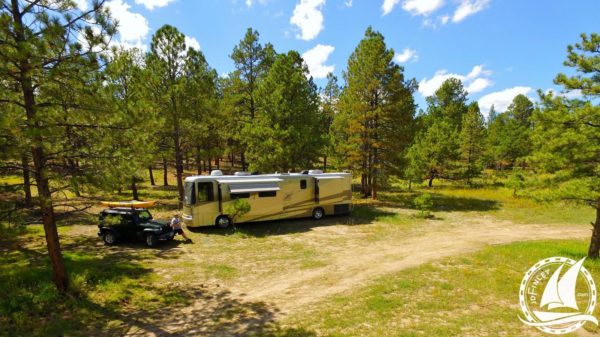Working full-time while living in an RV on the road is a recurring topic on various RV forums. Rather than continue to type up the same response over and over, I’m going to type it up one final time, and refer people here. Pretty smart cookie, eh?!?
We all know that every case/situation is different so I do not believe there is a single “right” approach. The following is the approach that works for me – it will not work for everyone – probably not most people, I am a strange lad. Maybe you can tailor it to an approach that works for you or maybe there is just a tip or two that is of some help.
I am a fulltimer – I live in my motorhome – also called fulltiming. I spend all my time west of the Mississippi and mostly along the continental divide in AZ, CO, ID, MT, NM, NV, WY. I spend the majority of my days boondocking on public lands. Some time is spent at state parks and private land. Very rarely I will stay at an RV park. It is very convenient and usually cost effective to occasionally (one night every 2-3 weeks) pull into a “campground” (that has water and dump station) to dump/fill my tanks, do a few loads of laundry, and take a long hot shower. I have on board laundry but it uses a lot of water. So the laundry and shower are both done in my “home” but are made easier with “unlimited” water and electric (hot water heater) hookups.

I am a software engineer and am employed full-time. I use a big laptop and I need to be connected to the Internet for the work day. My day is generally software development, source code repository updates, VPN connectivity, documentation, email, instant messaging, and use of a couple different collaboration tools (such as SharePoint) for documentation, bug tracking, etc.
In my opinion, there is only one “reasonable” option for Internet connectivity with this lifestyle: cellular data.
There are other options but they fall outside my definition of “reasonable”. Satellite is one (expensive) and Wi-Fi is another (spotty coverage, poor quality). If one desired to spend your time in RV parks, then Wi-Fi might be an option but good Wi-Fi is not as common as one might think. I have heard of people staying in RV parks and getting a DSL or cable modem installed. I suspect that works just fine but it must either lock you into staying in one place or dealing with a real nuisance every time one moves – not for me.
I tend to relocate my home/office on weekends to avoid conflicts with work. This is not ideal due to weekend campers coming and going. When I relocate, I must be sure I have a decent Internet connection wherever I end up. I have found some fabulous spots that had no cellular coverage so I had to find another spot – always a bummer. I try to plan plenty of time for this “search” so I don’t end up rushing (that’s when expensive mistakes happen) or trying to find a spot in the dark (nearly impossible and dangerous (scrapes and dents)).
The relocation process usually starts weeks in advance. I scour the Internet for ideas, review the National Forest and BLM maps, and even use Google Earth and Maps to take a look at possible areas. Google Maps has a nice “terrain” feature when in map mode. With it, one can see if your spot is high on a ridge or low in a valley or wash. You can also get an indication regarding the road/trail leading into the location. If it is going up and down over lots of topographical lines, it may not be a very good road. Next, I scout out a couple of places where I can park the motorhome while I take the Jeep to scout out my “possible locations.” Sometimes this is a big store/mall parking lot, sometimes nothing more than a wide spot in the road. So, I arrive in the intended area, unhook the Jeep, and drive to my target spots to take a look. I can get most anywhere in the Jeep so I have to remember why I am scouting – is the road passable with the RV, are the trees/branches out of the way, are there any corners that are too sharp for the RV, and so forth. I have no interest in damaging my motorhome or getting it stuck so I am pretty cautious.
Here in the west, Verizon easily has the best coverage. So, I have a Verizon 12 Gb data plan, phone, and tablet. I also have a Wilson (now weBoost) cellular amplifier and an external antenna on a long pole.
The logic behind having two devices (phone and tablet) is redundancy. If I lose or break one, I have a backup. Additionally, I keep my old phones for the same purpose. Both the phones and the tablets are setup with the “Mobile Hotspot” enabled. Some devices use different names but this is effectively turning the device into a WiFi access point. Obviously, setting up security so only your devices can connect is mandatory.
The 12 Gb data plan is what works for me. I have to be conservative with large downloads (here is how), system service packs and updates. For these, I make a run to a public Wi-Fi (McDonalds, Starbucks, etc.) and enjoy a cup of coffee while waiting.
My cellular amplifier is older model amplifier called the “Sleek 4G” from Wilson Electronics. It works as advertised and was not very expensive, I think about $100. Wilson Electronics is now called weBoost and they have newer models that I hear are working very well (Drive 4G). I’ve also heard positive reports about the “Max-Amp Mobile RV” kit.
The external antenna is only necessary when the cell signal is VERY weak. There are many approaches to this problem. My external antenna solution is more portable than permanent simply because I could not come up with anything that looked good on my coach and seemed rugged enough. I also went with a DIY approach and am satisfied with its performance. I suspect better performance is possible with some refinements but I have not found that effort to be necessary, yet. The goal is simply to get the antenna way up in the air to increase its chances of picking up a signal.
Finally, I have a desk that I constructed myself. It replaced one of the couches in my coach. It is not fancy but works very well for me.

Ok, enough “detail” – does it work?? YOU BET!! It works great!
The company for which I work cannot tell any difference from when I owned a sticks and bricks home (S&B) and worked from there. The only negative that I have not yet had to deal with is work travel. If I were forced to go on a business trip, it would be a little complicated. I can park my home at an airport in the long-term parking but I would have to find a sitter for my cat, Buddy. On a positive, I have visited the company office once in the motorhome and I stayed there and worked for a month which would not have been possible/desired if staying in a hotel.
I love the lifestyle, I love seeing and exploring different areas, I love having beautiful scenery out of my office window nearly every day, I love the peace and quiet. I know the solitude would drive some people insane, not me.






I just stumbled onto your blog… great site! I am a network design engineer and looking to go fulltime in 2018. I will also need to work remotely so the detail you give is very helpful. I noticed that you have a Dutchstar..40ft? We are looking at a Ventana 35ft with a Cherokee. Have you had any issues finding spots to fit into. I keep hearing people talking about the “limited” spots for larger rigs.
Thanks
Jim Morgan
Hi Jim! Thanks! Oh yes! The larger the rig more difficult it is to find spots – without a doubt. It is all a compromise – I occasionally wish I had a truck camper to get into the really great spots! I’m not sure about the east but here in the west: There is typically plenty of space on the public lands (BLM, Forest Service) for boondocking but the roads are sometimes the problem. The state park/forest service campgrounds usually have space for a 40′ rig but it is sometimes snug. Private rv park/campgrounds usually have room for larger rigs (though a few do not). Of course, there are always exceptions! If you look at my post from today you will see that I am wedged into a super neat spot but it was WORK to get into – I may be the only class A coach ever to have gotten into this spot! 🙂